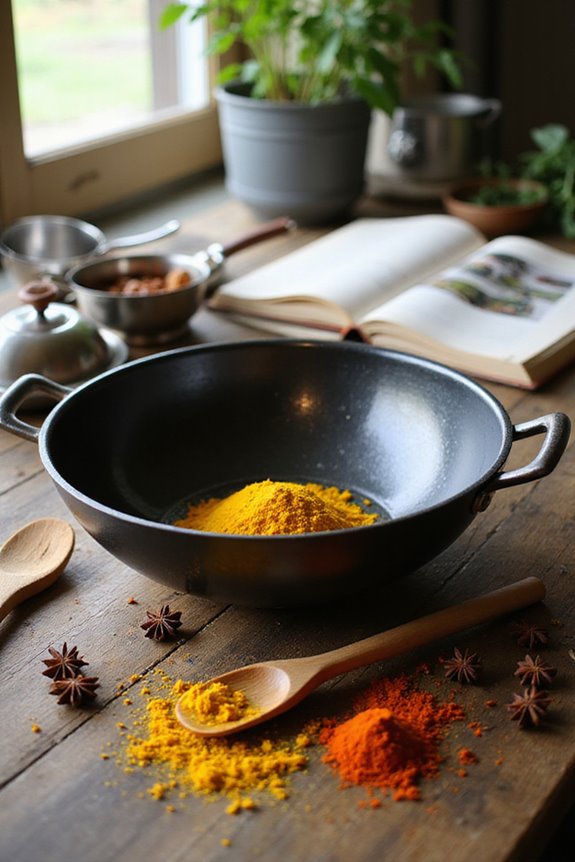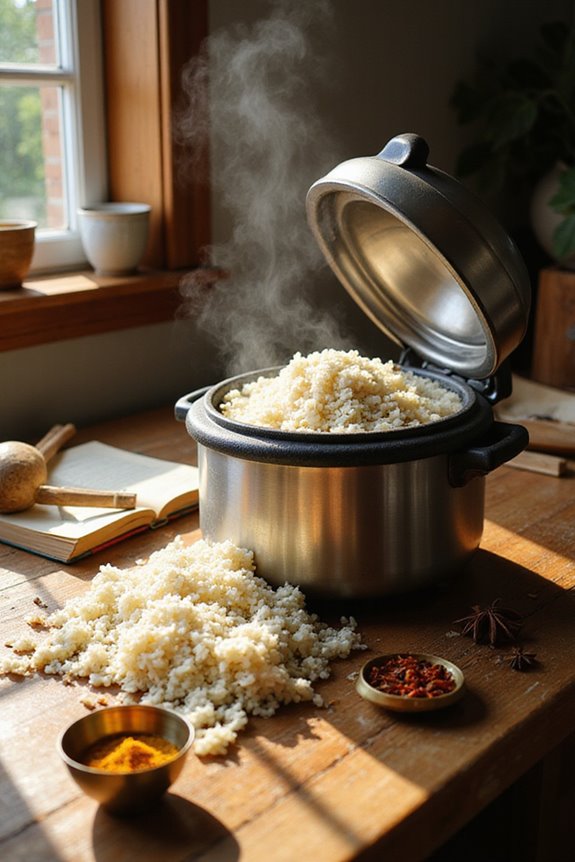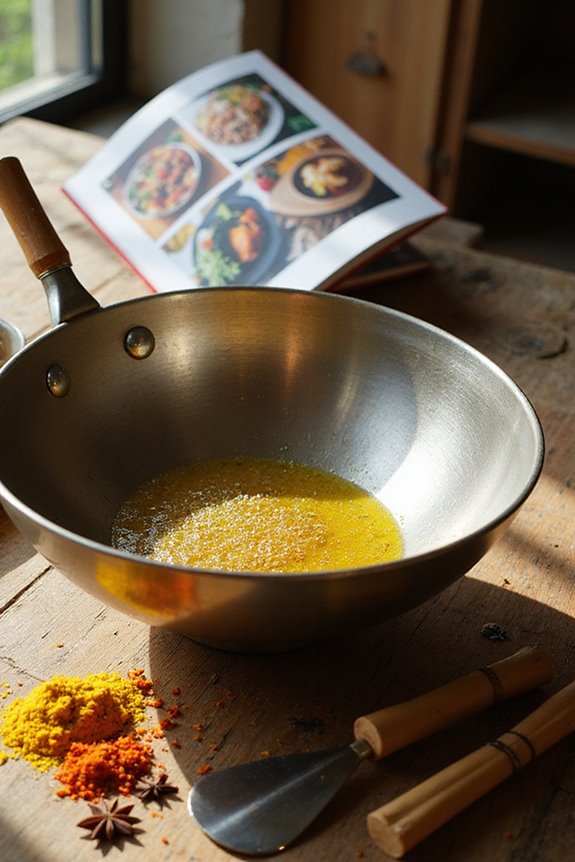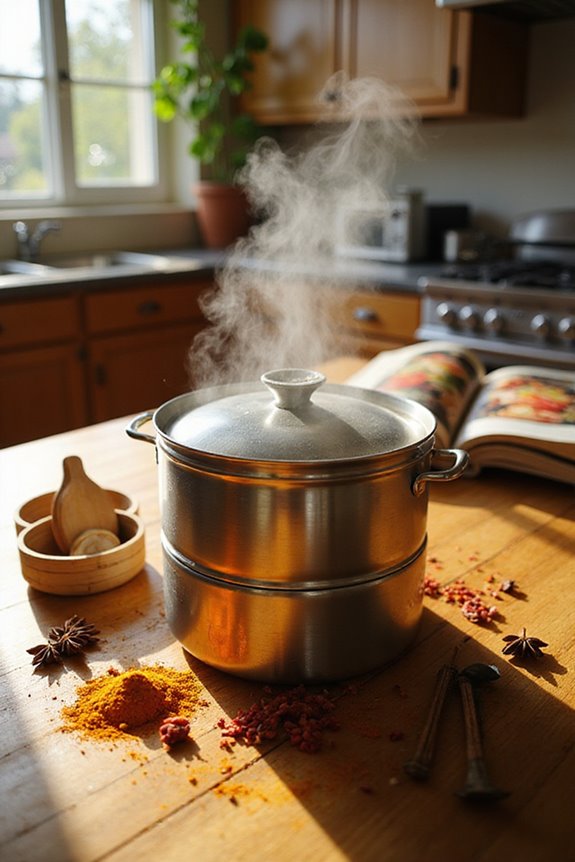To season a new carbon steel wok, let’s get the magic started! First, we’ll burn off any manufacturing oils with a powerful burner until it glows blue. Then, let’s coat it with a thin layer of high smoke-point oil, focusing on joint lines. Heat it up until it smokes and changes color—this forms our protective layer! Remember, less is more with oil, and a light touch keeps things delightful. Stick with us, and we’ll sprinkle in more tips on cooking!
Key Takeaways
- Start by burning off manufacturing oils using a powerful burner until the wok changes color from brown to blue for thorough cleaning.
- Ensure the wok is completely dry, then apply a thin layer of high smoke-point oil using a paper towel, focusing on joint lines.
- Heat the oiled wok until the oil starts smoking and changes color, allowing polymerization to create a solid protective layer.
- Maintain your wok by hand washing gently, drying thoroughly, and applying a thin layer of oil before storage to preserve seasoning.
- Regular cooking in your wok will strengthen the seasoning over time, enhancing its non-stick properties and overall durability.
Preparing the Wok for Seasoning
When we’re getting ready to season our carbon steel wok, a little preparation goes a long way! To kick things off, let’s focus on workspace preparation. Clearing any clutter is essential for safety and smooth sailing. Make sure we’re in a well-ventilated area since some smoke might dance around during seasoning.
Next up is material gathering. Here’s what we need:
- A trusty carbon steel wok
- High smoke-point oil (grapeseed, vegetable, or canola)
- Paper towels for oil application
- Scrub sponge for pre-cleaning
With our protective gear ready (oven mitts, anyone?), we’re one step closer to a delightful cooking adventure. Remember, getting these things sorted now means seasoning our wok will be magical! Using high-grade materials like those found in premium kitchen tools ensures durability and performance in our cooking endeavors.
Burning Off Manufacturing Oils
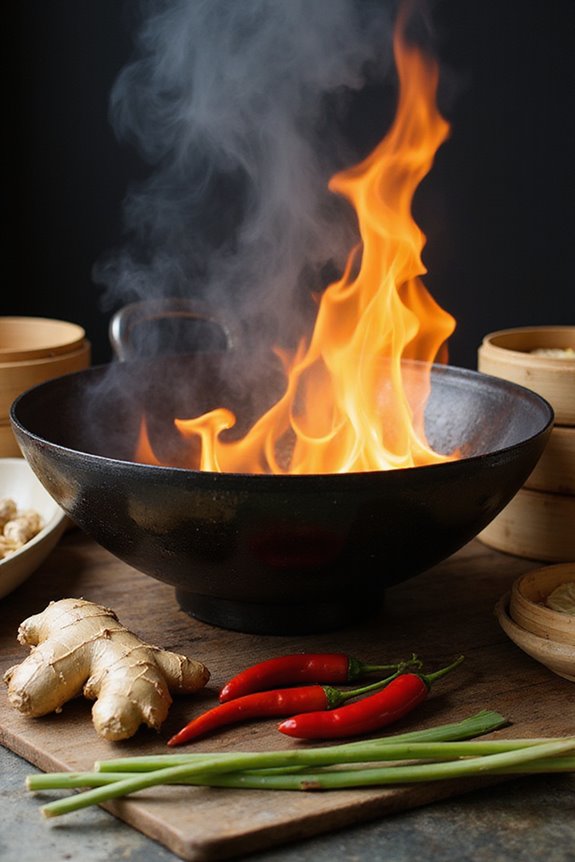
Before we immerse ourselves in the magic of seasoning, burning off those pesky manufacturing oils is crucial for our carbon steel wok. This is where we employ some handy burning techniques. We’ll need a powerful burner to achieve high heat. As our wok heats up, let’s keep an eye on those color changes from brown to blue—this shows the oil removal is working!
Additionally, using high heat tolerance ensures we effectively remove those oils without damaging the wok.
Tips to remember:
- Rotate the wok to guarantee even heating.
- Watch the temperature; too much heat can mean disaster!
- Don’t forget thermal gloves to protect our hands.
Once we’ve completed this crucial step, we’ll set our wok up for delicious culinary adventures! Happy cooking, everyone!
Applying the First Layer of Oil
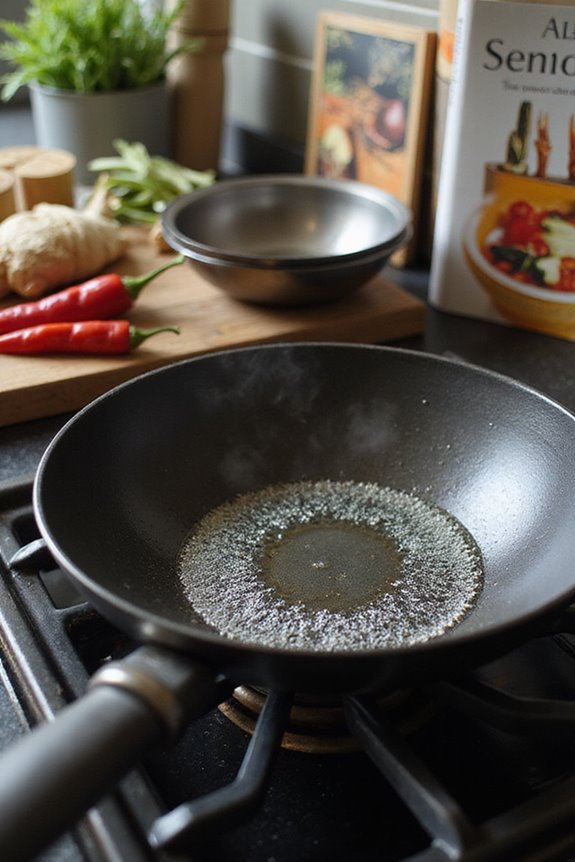
Applying that first layer of oil to our carbon steel wok is like giving it a cozy blanket for its culinary journey! For this delightful oil application, we’ll need a neutral oil with a high smoke point—grapeseed or canola work wonderfully.
Here’s How We Do It:
- Confirm our wok is completely dry after washing away those manufacturing oils.
- Using a paper towel, we’ll spread a thin layer of oil evenly over the inside and outside, focusing on those tricky joint lines too!
- Remember, less is more; it shouldn’t feel greasy, just a beautiful, faint shine. This process helps create a non-reactive surface that will enhance the flavors of our dishes.
Let’s enjoy this magical step together as we prepare our woks for many delicious meals to come!
Polymerizing the Seasoning
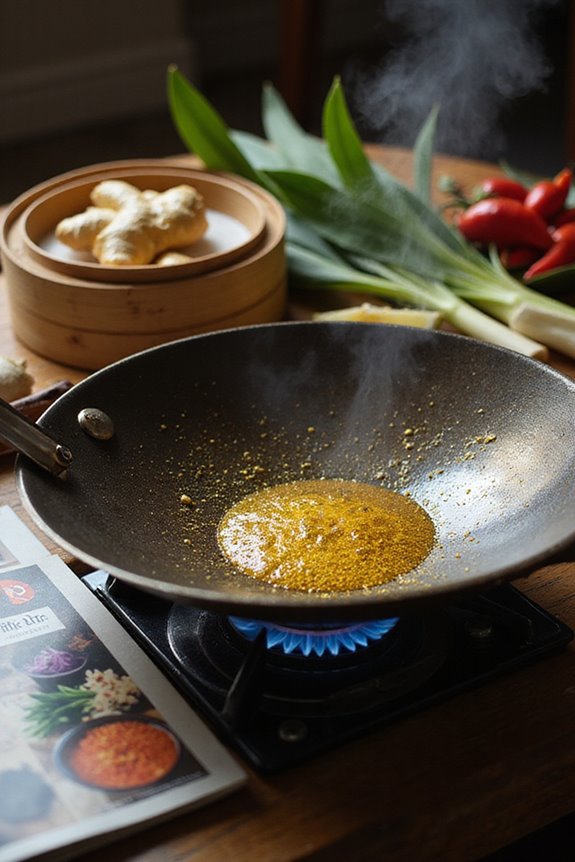
Polymerizing the seasoning on our carbon steel wok is like casting a protective spell, ensuring our culinary companion is ready for delicious adventures! This magical polymerization process transforms heated oil into a solid surface that fills our wok’s pores, creating a delightful non-stick layer.
To make it happen, we need to:
- Dry the wok: Keep it squeaky clean!
- Heat it up: Get that wok warm and ready.
- Use high smoke point oils: Think grapeseed or flaxseed!
As the oil smokes and changes color, we’ll see our protective layer form. This remarkable seasoning provides incredible durability and prevents rust! Additionally, using high-temperature cooking equipment during this process can enhance the effectiveness of the seasoning. So, let’s embrace this exciting journey to flavor-packed meals together!
Additional Seasoning Cycles
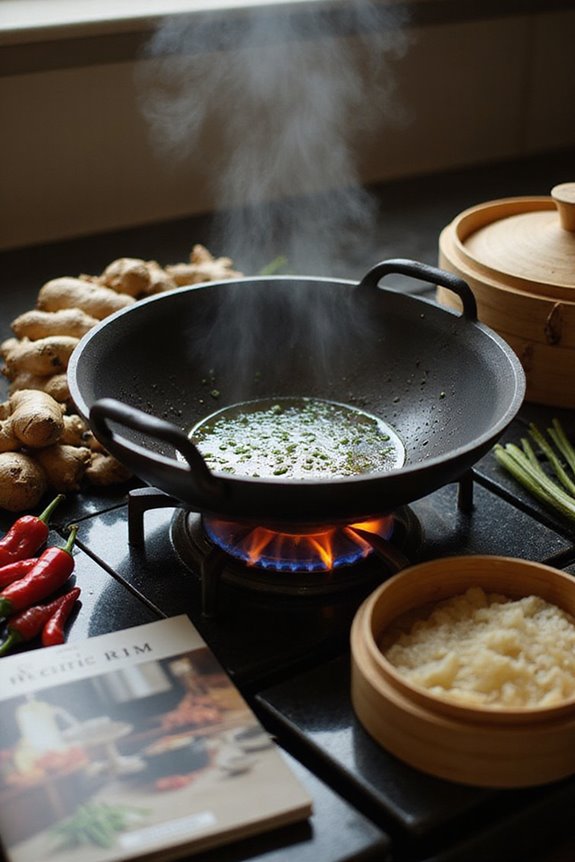
- Seasoning frequency matters! Each time we apply a thin, even layer of high smoke point oils like peanut or grapeseed oil, we’re filling those metal pores.
- Heat our wok until the oil starts to smoke lightly; then maintain it for 5 to 10 minutes. Repeat this 2-3 times!
- Don’t forget to let the wok cool completely between cycles to help that delightful polymerized oil harden nicely.
With each cycle, we’re not just seasoning; we’re building a protective shield against rust—how magical! Cooking at high temperature settings can enhance the seasoning process by ensuring the oils adhere well to the wok surface.
Maintenance for Longevity
When we take care of our carbon steel wok, we’re setting the stage for culinary adventures that will have our taste buds dancing! To guarantee our maintenance routines promote seasoning longevity, we should adopt a few simple habits:
- Wash by Hand: Treat your wok gently—hand wash only!
- Dry Thoroughly: No one likes soggy woks. Wipe it dry immediately!
- Store Right: Apply a thin layer of oil before tucking it away in a dry place.
- Use Regularly: The more we cook, the stronger our seasoning gets! Additionally, using an eco-friendly approach, such as opting for bamboo cutting boards, can help maintain a sustainable kitchen environment.
Tips for Best Seasoning Results
To achieve delightful seasoning results with our carbon steel wok, it’s essential to follow a few key steps that’ll make the process feel almost magical!
Oil Selection: We recommend using high smoke point oils like grapeseed or canola for the best results. Thin layers work best, so don’t use too much!
Seasoning Techniques: Start by scrubbing the wok to remove any factory coating. Then apply oil evenly with a cloth. Heat it up until it smokes—this is where the magic happens! Repeat this process a couple of times for glorious seasoning.
Cooking With Your Seasoned Wok
Cooking with our seasoned wok can feel like stepping into a culinary wonderland, where flavors and textures dance together in delightful harmony! Let’s embrace some stir fry techniques. First, we preheat our wok on medium-high heat—when a drop of water sizzles away, we’re ready! Next, we swirl in high smoke point oil to coat the surface, ensuring even heat and happy ingredients.
When we handle our ingredients, uniform cutting is key. Add aromatics first, then proteins, and finish with veggies to keep everything cooking evenly. Tossing quickly is essential—imagine it’s a festive dance party! With a bit of practice, we’ll all master our culinary magic in no time and create memorable meals together!
Troubleshooting Common Issues
Even the most seasoned chefs encounter bumps along the road to culinary perfection, and that’s perfectly okay! If we notice sticky spots or uneven seasoning, let’s not fret. These little hiccups happen as we embrace our new wok. Here are a few tips:
- Fixing Spots and Stains: If we see spots, it may mean the wok wasn’t dry enough before oil application. Simply wipe away excess oil with a paper towel.
- Battling Sticking Food: When food sticks, it’s usually a sign the seasoning needs a bit more love. We might need to re-season or do some spot seasoning.
Enhancing the Flavor With Natural Seasoning
When we think about enhancing the flavor of our dishes, natural seasoning plays a magical role in transforming our carbon steel wok into a culinary powerhouse. By building layers of polymerized oils, we create a nonstick surface that not only protects our wok but also deepens flavors over time. Here’s how to make it work:
- Choose the right oil: Use high smoke point oils like grapeseed or peanut oil for that perfect flavor development.
- Multiple thin layers: Apply and heat thin coats of oil until they shimmer, building a delightful patina.
- Regular maintenance: After cooking, a light touch of oil keeps flavors alive, just like sprinkling glitter on holiday cookies!
Let’s make our cooking adventures filled with amazing flavors!
Frequently Asked Questions
Can I Season My Wok in an Electric Oven?
Sure, we can absolutely season our wok in an electric oven! Just remember to prioritize oven safety—predetermine temperatures, check for flammable items, and enjoy the transformation as our meals become delightful culinary masterpieces.
What Is the Best Oil for High-Temperature Seasoning?
When we’re considering the best oil for high-temperature seasoning, we should focus on oils with a high smoke point. We typically recommend using them for longer seasoning durations to guarantee ideal results and durability.
How Often Should I Reseason My Carbon Steel Wok?
When it comes to wok maintenance tips, we should keep an eye out for seasoning frequency guidelines. Regular seasoning guarantees our wok remains a joyful companion, enhancing our culinary adventures while keeping those pesky sticking troubles at bay.
What Cookware Should I Avoid Using With a Seasoned Wok?
When we think about our seasoned wok, we should definitely avoid non-stick cookware and aluminum pans. They can damage the seasoning, leading to less flavor and joy in our cooking adventures together. Let’s cherish our woks!
Can I Wash My Seasoned Wok With Soap?
Did you know 70% of experienced cooks avoid soap for cleaning methods? We recommend using soap alternatives like hot water and salt scrub, ensuring we keep our seasoned wok’s flavor intact while still maintaining its pristine condition.

